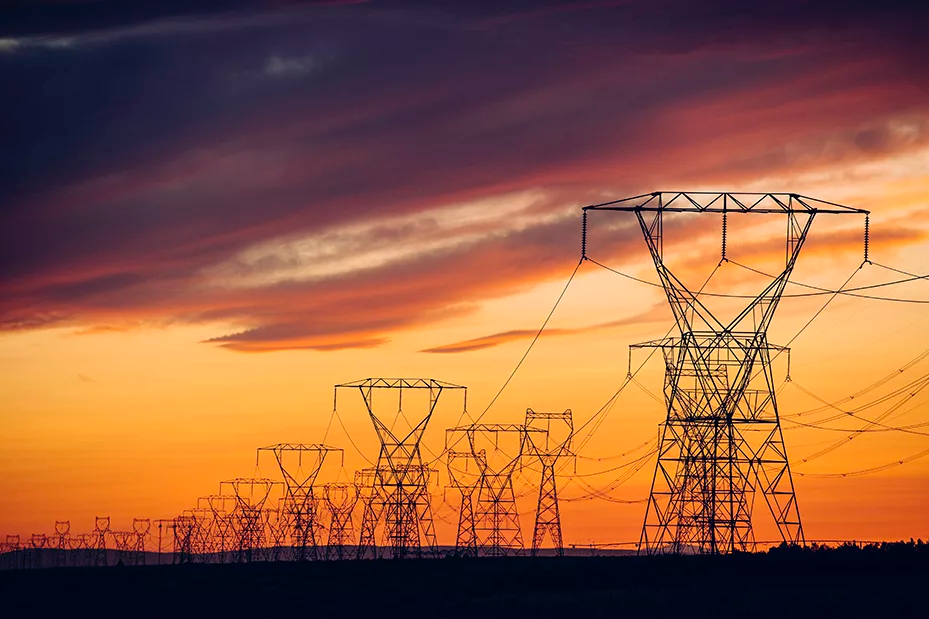For decades, America’s economic might has depended on invisible infrastructure — the high-voltage arteries that keep factories running, cities lit, and defense systems powered. But those lines are now reaching the end of their engineered lifespans. Beneath the debates about AI, EVs, and industrial policy lies a simple fact: the U.S. power grid is too old, too fragmented, and too politicized to carry the weight of the twenty-first century.
Aging Infrastructure, Rising Stakes
Fred Bailey of The National Interest notes that over 70 percent of America’s high-voltage transmission lines are more than 25 years old, with many approaching or exceeding their 50-year design life. That’s not just a maintenance issue; it’s an existential risk for an economy increasingly dependent on uninterrupted, high-capacity electricity.
Every sector driving the “next economy” — from AI data centers to electrified manufacturing and advanced defense production — runs on power-hungry infrastructure that demands stable, scalable transmission. When lines fail, the cost isn’t just lost productivity. During recent blackouts and storms, outages have erased billions of dollars per day in GDP, food supply, and emergency operations losses.
The Strategic Dimension
Bailey’s companion piece argues that transmission must be treated as strategic infrastructure, not merely a utility function. As The Economist recently put it, “America’s most underappreciated national-security asset is not its aircraft carriers but its copper and aluminum.” A resilient, interconnected grid isn’t only about energy efficiency — it’s a deterrent against cyberattack, natural disaster, and geopolitical manipulation.
Right now, the U.S. grid remains balkanized — a patchwork of local monopolies and regional authorities. Power-rich areas like the Plains often curtail surplus generation during crises because interregional transmission is inadequate. E&E News found that in 2022, while Winter Storm Elliott caused rolling blackouts in the South, gigawatts of cheap wind power were idled hundreds of miles away for lack of connection.
Why the Rebuild Stalls
Permitting paralysis is one culprit: as Reuters reports, new high-voltage lines take seven to ten years to permit and build, often spanning multiple jurisdictions that fight over routing and environmental review. Utilities, constrained by state-level rate caps, delay upgrades because there’s no guaranteed cost recovery. And federal policy has failed to establish a national planning framework; each region optimizes locally while the national grid degrades globally.
The result: America built just 322 miles of new 345 kV or higher transmission last year — a rounding error compared to the needs of AI-scale energy growth.
Economic Math for a New Era
Studies show that every $1 invested in high-capacity transmission yields $3 to $7 in consumer and productivity benefits. In Texas, the CREZ projects delivered $78 billion in benefits on a $6.9 billion cost. Bailey’s analysis highlights a national average return of $5 for every $1 invested, from reduced congestion and lower energy prices to improved industrial reliability.
But those aren’t just spreadsheets — they’re the quiet economics of resilience. A modernized grid functions like an insurance policy against both natural and adversarial shocks. The avoided losses during disasters can outweigh construction costs several times over.
AI, Industry, and Energy Sovereignty
AI’s hunger for power may be the final catalyst. The International Energy Agency projects data-center demand will grow by 50 percent within the decade. Those facilities aren’t mere tech campuses; they’re infrastructure for defense, cybersecurity, and intelligence. Power interruptions aren’t inconveniences — they’re vulnerabilities.
By rebuilding domestic capacity — from aluminum and steel refining to battery-grade materials — the U.S. can sever dependence on adversaries for critical minerals and manufacturing. Transmission, in that context, becomes the geopolitical hinge between industrial self-sufficiency and strategic exposure.
From Utility to Grand Strategy
To move from rhetoric to results, Washington must treat grid modernization the way Eisenhower treated the Interstate Highway System: as a multi-decade national imperative, not a short-term capital project. Bailey calls for a dual focus — upgrading existing corridors with advanced conductors and Grid-Enhancing Technologies, while simultaneously building a 50-year backbone of 765 kV interregional lines.
The payoff isn’t abstract. As The Economist’s energy desk framed it this summer, “Electrification will determine the winners of the next industrial revolution — and America’s grid is not yet in the race.”
Conclusion
America’s power grid is now both its most valuable economic asset and its greatest liability. The physics of electricity are indifferent to politics; current still follows the path of least resistance, and so does decline. The question is whether policymakers will recognize transmission as what it is — the foundation of national security and economic sovereignty — before the next blackout becomes the next crisis of confidence.
Sources:
- The National Interest – “Infrastructure for the Next Century: Transmission as a Strategic Asset” (Aug 26, 2025)
- The National Interest – “Past Its Prime: Why Aging Transmission Lines Threaten the Modern Grid” (Sep 18, 2025)
- The Economist – “America’s Electric Future Needs a New Grid” (Aug 2025)
- Reuters – “US Transmission Buildout Stalls amid Permitting Delays” (Jul 2025)
- E&E News – “Winter Storm Elliott and the Limits of America’s Power Grid” (Dec 2024)

